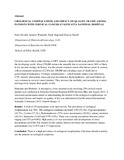| dc.contributor.author | Nassir, Faiza | |
| dc.contributor.author | Wanjala, Samson | |
| dc.contributor.author | Kagema, Frank | |
| dc.contributor.author | Njeru, Erastus | |
| dc.date.accessioned | 2013-11-29T11:40:25Z | |
| dc.date.available | 2013-11-29T11:40:25Z | |
| dc.date.issued | 2013-06 | |
| dc.identifier.citation | Nassir, Faiza,Wanjala, Samson,Kagema, Frank,Njeru, Erastus,;Urological Complications And Impact On Quality Of Life Among Patients With Cervical Cancer At Kenyatta National Hospital,presented at the 2nd International Scientific Conference, Chs And Knh, 19th - 21st June 2013. | en |
| dc.identifier.uri | http://hdl.handle.net/11295/61115 | |
| dc.description | Urological Complications And Impact On Quality Of Life Among Patients With Cervical Cancer At Kenyatta National Hospital,presented at the 2nd International Scientific Conference, Chs And Knh, 19th - 21st June 2013. | en |
| dc.description.abstract | Cervical cancer whose main etiology is HPV remains a major health issue globally
especially in the developing world. About 270,000 women die annually due to cervical
cancer; 88% of them in low income settings. In Kenya, it is the second common cancer
after breast cancer in women, with an estimated incidence of 2,454 per 100,000 and
a leading cause of death due to gynecological malignancy. Urologic complications—
which include urinary tract infections, VVF, ureteric obstruction, stress and urge
incontinence, hydronephrosis, and renal failure are very common in cervical cancer
patients. They increase the morbidity and mortality in women and negatively impact
their quality of life.
Materials and Methods: A descriptive, cross sectional study involving 239 cervical
cancer patients was conducted at Kenyatta National Hospital (KNH) between May
and August 2012. A structured questionnaire aimed at understanding the burden of
the urological complications, its associated factors and impact on quality of life was
administered.
Results: A total of 239 participants were interviewed. The prevalence of
urologicalcomplications was 78%. The urological conditions included; UTI
(55.1%), Urge incontinence (42.7%), Cystitis (37.2%), Hydronephrosis (37%)
stress incontinence (26.8%), urinary retention (20.1%), hematuria (12.6%)and
VVF (10%).
There was a strong association between cancer staging and UTI (p=0.002). High
parity (>3) was associated with development of stressincontinence (p=0.06).The
median for the urinary distress inventory and incontinenceimpact questionnaire
was 21.875 and 4.17 respectively.
Conclusion: There is a highprevalence of urological complications Clinicians
should routinely ask the patients on urological symptoms. | en |
| dc.language.iso | en | en |
| dc.publisher | University of Nairobi | en |
| dc.subject | Cervical Cancer, Urological complications; Quality of Life | en |
| dc.title | Urological Complications And Impact On Quality Of Life Among Patients With Cervical Cancer At Kenyatta National Hospital | en |
| dc.type | Presentation | en |
| local.publisher | College of Health Sciences | en |

